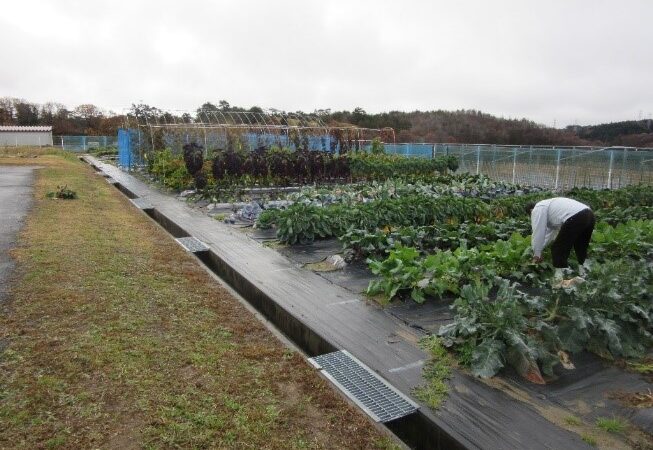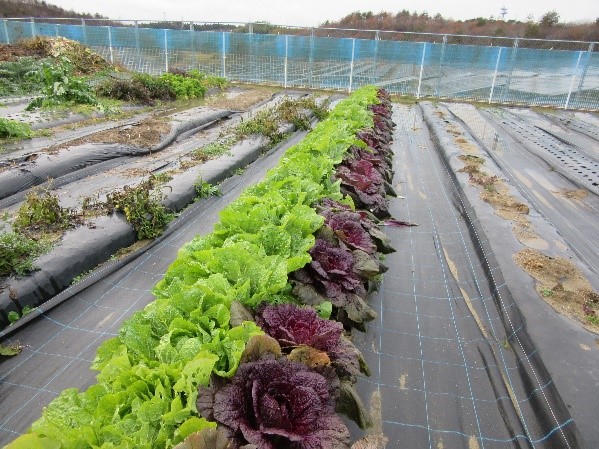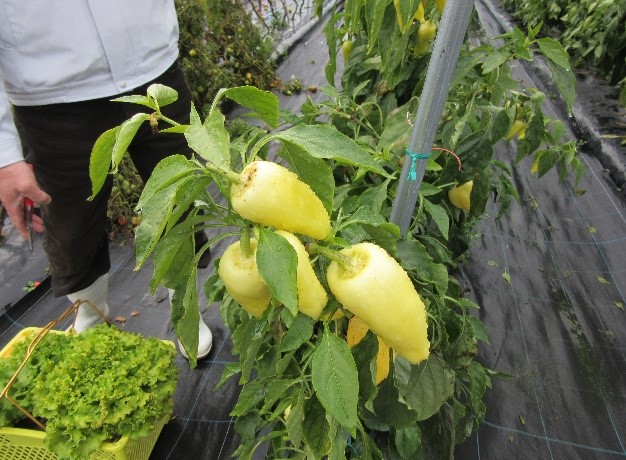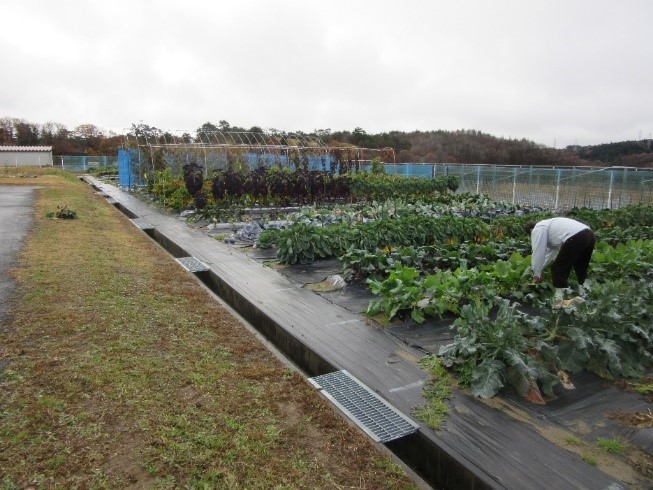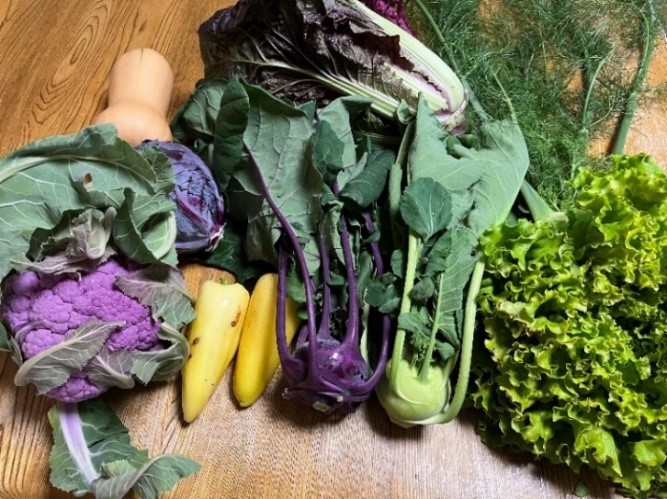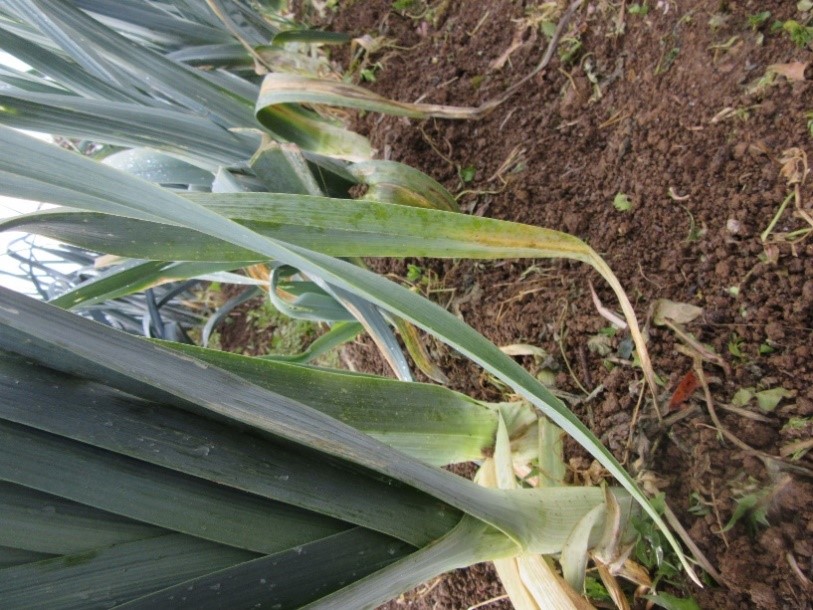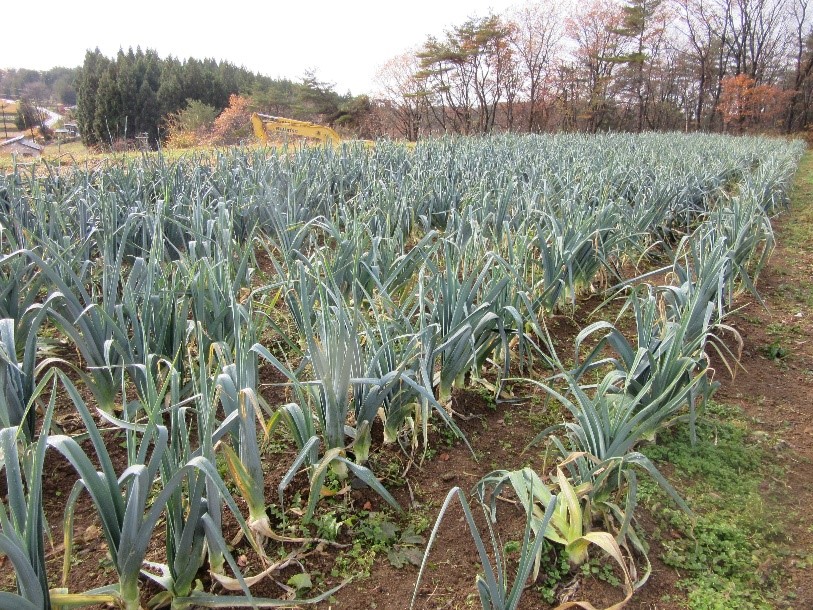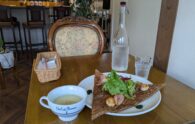Though we have posted many articles about the Western Vegetable Project in Ichinoseki, we wanted to give you all an update!
URL:https://www.iwate-ilc.jp/eng/ktimes/making-ichinoseki-a-huge-producer-of-western-vegetables/
First let’s talk about the “Western vegetables” grown in Iwate. A majority of the vegetables normally eaten in Iwate are western or were brought in from overseas but not all of these are considered western vegetables. Vegetables like potatoes, onions, eggplants, tomatoes and carrots are vegetables that are sold at most stores and are already widespread so they are not called western vegetables.
Some vegetables that are considered western are things like radish, watercress, beets, chicory and leeks. In many cases, buying western vegetables like these is done at the farmer’s markets or online, since not very many stores stock them.
The Ichinoseki “Southern Agricultural Technology Development Center” is aiming to cultivate and popularize western vegetables in Ichinoseki, as the city is a candidate construction site for the ILC.
“Ichinoseki Southern Agricultural Technology Development Center” (Hanaizumi Ichinoseki)”
I did an interview with them, so let’s cover that first.
Q1 Among other things, I saw you cultivating chili peppers, kale, and fennel. How is the 2021 crop coming along?
A1: In 2021 we have implemented a strategy to prevent the loss of yield from growing the same crop in the same field, and got the harvest we had hoped for. We have cultivated the crops throughout the season in a way that speeds up the two crop rotation system in place, in order to ensure there are no empty spaces and create a beautiful looking field. By reviewing our cultivation methods from square one, we have stabilized the yield of our second crop. We were able to realize our aim to provide a variety of vegetables to local restaurants by increasing production.
Because of the state of emergency in 2021, the number of people coming on field trips to the farm have decreased but, the people who have come have rated our vegetables highly. We are currently cultivating all in all 110 different kinds of vegetables.
【Crispino Lettuce】
【Paprika】
【State of the garden】
Q2 Are there any new updates on the 6 farmers who you were working with to grow shallots in 2020?
A2 There are still 6 farmers growing shallots. We have been farming together and keeping a record of the growth of the crops during the routine inspections of the fields. We have also been conducting online meetings to improve cultivation techniques. One of the biggest problems is that some farmers are not able to get the harvest they hoped for because of the lack of manpower during the summer time.
Q3 Do you do any western vegetable cultivation work with Iwate’s “Agricultural Extension Center” and “Japan Agricultural Cooperatives (JA)”?
A3 We asked them for supervision and the final check regarding the crop calendar of shallots and leeks, and as well as when we created the pest control calendar. We had the JA provide us data of their green onion crop calendar which we used as the foundation for ours.
Next, I will explain a bit about the [HELLO Western Vegetables Fair] that we have been working on.
At the fair, restaurants and cafes from around Ichinoseki offered an original menu featuring western vegetables that were produced in the city. Customers could get those recipes by answering a questionnaire. The event was held twice last year, from July 31st to August 31st and November 20th to December 19th and was organized by the “Ichinoseki Southern Agricultural Technology Development Center”.
Q4 Using the “HELLO! Western Vegetable Fair” as a place where the general consumer is able to eat western vegetables is certainly an interesting plan, but why did you want to start it in the first place? How was the reaction?
A4. The goal was to connect restaurants with farmers, farmers with consumers, and consumers with restaurants.
According to restaurant staff, there were high levels of interest in their recipe books. I think this fair made people want to learn more about western vegetables. A chef was saying there were many questions about rhubarb and the like, and so I think the interest in western vegetables has grown.
Q5 Was there anything that you found difficult? How do you plan to expand from here on out?
A5. The vegetables that each participating shop wants to use are different, and there are certain preferences towards specific types of produce they use so I have made great efforts get those vegetables to them. Also the number of people participating in the fair didn’t increase as I was hoping because there was a state of emergency, so that was tough.
During our first half of the fair, we offered vegetables in August at the center, but the growers weren’t able to offer their produce to customers. However in the second half of the fair, the growers also were able to sell their produce to customers. We are aiming for a fair where the restaurants use the vegetables grown by the farmers to serve dishes to citizens, so we would like to increase more of these interactions.
So far, I feel that the vegetable growing information from the growers and restaurant usage information hasn’t been well connected, and so I want to strengthen the relationship and make the fair one where each party can understand the other’s situation. Finally we hope to increase the number of restaurants participating and plan a big get together event for everyone once the number of participating farms and restaurants gas reached a high enough number.
I was shown the farm and enjoyed looking at the many colourful vegetables they had to offer despite the fact that it gets colder day by day this time of year.
From this interview I am reminded again that the connections to restaurants and consumers are very important. I received a variety of vegetables on my way home from the center, which I heard are also given out to others who come to see the farm as well. There were vegetables similar to those often eaten in Japan like lettuce, pumpkin and Chinese Cabbage and I enjoyed eating them. The vegetables you are unfamiliar with have many recipes that you can use with them online if you search them up so by all means give it a try. It was a valuable experience for me as well.
Anybody can come and visit the center if you make a prior reservation, so if you get the chance to visit Ichinoseki come by and give it a look!
【Vegetables I received】
Next I visited farmer who grows leeks to ask some questions.
Q.Why did you want to start growing western vegetables? What are some of the struggles you have had so far?
A. I was introduced to leeks out of the western vegetables by the people at the “Ichinoseki Southern Agricultural Technology Development Center”. We started growing them from 2020 since the planting calendar didn’t overlap with my other crops. We are struggling a bit since leek cultivation is different from the green onions we have grown until now. We are growing around 3000 leeks in about 400m2 of land but, everything from planting to weeding is done by hand so the manual labour is a struggle too.
We hardly harvested anything in the first year but in 2021, once we changed our fields from a slope to a flat piece of land, we were able to have a big harvest of leeks.
I was able to see the leek crop myself, and I was surprised by how thick they were. They are about two times as thick as the green onions we use in miso soup and hot pots. (They say they are grown to about 5 centimeters thick)
【Leek farm pictures】
After interviewing the farmers, I went to HIRASAWA F MARKET which participates in the “Western Vegetable Fair” (In Sannoseki, Ichinoseki). I had a sandwich that had tartar sauce made from shallots. I thought the spice and fragrance suited the tartar sauce perfectly.
【The restaurant I had lunch at】
The center that organizes the “Western Vegetable Fair” has said that they would like to hold the fair a third and fourth time. It’s a great chance for people to try various western vegetables so I want them to continue running them. I am hoping for the further development of farmer and restaurant relations as well as increased western vegetable related activity.
Japanese
西洋野菜を岩手県で広めよう!一関市における西洋野菜プロジェクトについて今までに何度か記事を掲載していますが、最近の状況をご紹介したいと思います!
URL:https://www.iwate-ilc.jp/eng/ktimes/making-ichinoseki-a-huge-producer-of-western-vegetables/
まずは岩手における「西洋野菜」についてお話しします。岩手で一般的に食べられている野菜も多くは西洋など海外から持ち込まれたモノが大半となっていますが、これらすべてを西洋野菜とは呼びません。ほとんどのお店で売られているジャガイモやタマネギ、ナス、トマト、ニンジンなど、これらの野菜は一般的に普及しているので、西洋野菜とは呼ばれておりません。
西洋野菜と呼ばれている野菜で挙げられるのは、ラディッシュやクレソン、ビーツ、チコリー、リーキなどです。これらの西洋野菜を取り扱っているお店はあまり多くないため、購入する際には産直や通信販売等を利用することが必要となるケースが多いと思います。
ですが、建設候補地である一関市で西洋野菜の栽培や普及等に取り組んでいるのが以前にもご紹介した「一関市南部農業技術開発センター」です。
【一関南部農業技術開発センター(一関市花泉町)】
まずは取材にお答えいただいたので、そちらをご紹介いたします。
Q1 ビキーニョやケール、フェンネル等の栽培の様子を拝見させていただきましたが、今年(2021年)の生育状況はどうですか?
a1 2021年は、連作障害の対策をしっかりと行い、期待する収穫ができました。また、見せる圃場を念頭にシーズンを通して畑に空きが出ないよう2作作型での切り替えを早めるよう栽培を進めました。また、栽培方法も一から見直したことにより、2作目の品目も安定して生産できていますし、多くの食材を地域の飲食店に届けようと増産を目指す取組も実践してきました。
2021年夏の緊急事態宣言などにより圃場見学会来場者はその前の年より少なくなりましたが、最終的に110種の栽培品目となり、来場者からは高い評価を頂いています。
【クリスピーノ】 【パプリカ】 【圃場の様子】
Q2 2020年から若手農家6名とシャロット栽培の取組を始めたとのことですが、その後、新たな展開はありましたか?
a2 栽培者は引き続き6名ですが、共同作業や栽培歴を作成しての定期的な圃場巡回、ウェブでの打ち合わせ会議など栽培技術の向上を進めてきました。夏場の労働力不足により、農家によっては思うような収量にならないのが課題です。
Q3 西洋野菜の栽培などに関して、県の農業改良普及センターやJA等と連携した取り組みはありますか?
a3 シャロット、リーキの栽培暦、防除暦を作成するにあたり、県の農業改良普及センターには監修と最終的なチェックをお願いしました。JAには、栽培暦の土台とするため「ねぎの栽培暦データ」を提供してもらいました。
ここで西洋野菜に関する取組の1つである「HELLO!セイヨウヤサイフェア」をご紹介します。
このフェアは、一関市内のカフェやレストランが一関市内で生産された西洋野菜を使ったオリジナルメニューを提供し、アンケートに答えたお客さんはそのレシピをもらえるというもので、一関市南部農業技術開発センターが主催し、2021年の7月31日~8月31日と11月20日~12月19日の2回にわたって開催されました。
Q4 「HELLO! セイヨウヤサイフェア」は一般消費者に西洋野菜を食べて知ってもらうことができる面白い企画だと思いましたが、なぜ実施しようと思いましたか。反響はどうでしたか。
a4 目的としては、飲食店と生産者、飲食店と消費者、そして、生産者と消費者のつながりを作ることでした。
飲食店の方によると、レシピブックへの関心が高く、西洋野菜を知るきっかけになったと思います。ルバーブなどは問い合わせが多いとシェフも話しており、食材への興味も広げられたと思います。
Q5 苦労した点はありますか?また、これからどのように展開させていきたいですか?
a5 それぞれの参加店が使いたい野菜が異なっていたり、使う品種に偏りがあったりするので、きちんと野菜をお届けするのに苦労しました。また、期間中に緊急事態宣言があったことで、思うように来客数が伸びなかったことも大変でした。
8月の第1回では当センターで栽培した野菜を提供し、生産者からの食材提供はありませんでしたが、2回目には生産者からの食材提供もありました。生産者が作る野菜を飲食店が料理にして市民の皆さんに提供できる姿を目指していますので、こうした動きをもっと増やしていきたいと思います。
また、生産者の作る情報、飲食店の使う情報がうまくつながっていないと感じており、もっと交流を高め、お互いの顔が見えるフェアにしたいと考えています。さらに飲食店の参加店舗を増やし、生産者も飲食店も十分な時期になったところで、一か所の会場に集まって行うイベント“フェス”へと発展させていきたいと考えています。
実際に圃場を見させていただきましたが、寒くなりつつある季節にもかかわらず、カラフルな野菜が多く、それらを見ているだけで楽しむことができました。
また、今回の取材で改めて、飲食店や消費者とのつながりが大事だと思いました。
センターからの帰り際には多くの野菜をいただきました。圃場見学に来た人には配っているそうです。いただいた西洋野菜は、日本でも普段から食べられているレタスやカボチャ、白菜に似ている野菜などもあり、おいしくいただきました。なじみのない野菜もインターネットで検索すると様々なレシピが紹介されていますので、ぜひチャレンジしてください。私も今回は貴重な経験をすることができました。
センターの見学は申し込めばだれでも参加することができるので、一関市に足を運ぶ機会があればぜひご覧いただければと思います。
【いただいた野菜】
次にリーキの栽培に取り組んでいる生産者を訪問し、お話を伺いました。
Qなぜ西洋野菜の栽培に取り組もうと思いましたか。また、苦労したことはどのようなことですか。
a 「一関市南部農業技術開発センター」の方に西洋野菜の中からリーキを紹介してもらいました。ほかに栽培している農作物と作業時期が重ならず、栽培可能だったため2020年から取り組みました。これまで手掛けてきたネギと栽培方法が異なるため育てるのに苦労しています。また、このリーキはおよそ4アールの土地に約3000本栽培していますが、植え付けから草取りなども手作業で行っているのでその点も苦労しています。
1年目はほとんど収穫することができませんでしたが、2年目は栽培場所を斜面から平面に変えたところ、多くのリーキを収穫することができました。
実際にリーキを栽培している様子を拝見しましたが、その太さに驚きました。リーキの太さは日本でお味噌汁や鍋料理等に使われている長ネギに比べて太さが2倍くらいありました。(太さが5cmほどになるまで成長させるそうです。)
【リーキの栽培の様子】
生産者の取材を終えたあとに「セイヨウヤサイフェア」に参加しているお店「HIRASAWA F MARKET」(一関市三関)にも行ってきました。こちらのお店ではエシャロットのタルタルソースを使ったサンドイッチをいただきました。ほどよい辛みと香ばしさがタルタルソースにぴったりだと思いました。
【ランチをいただいたお店】
「セイヨウヤサイフェア」の主催者であるセンターでは第3弾、第4弾と続けていきたいということでした。多くの西洋野菜料理に触れる機会になるので、ぜひ続いてほしいと思います。また、生産者と飲食店の関係が発展し、西洋野菜の取組がさらに活発になっていくことを期待しています。
